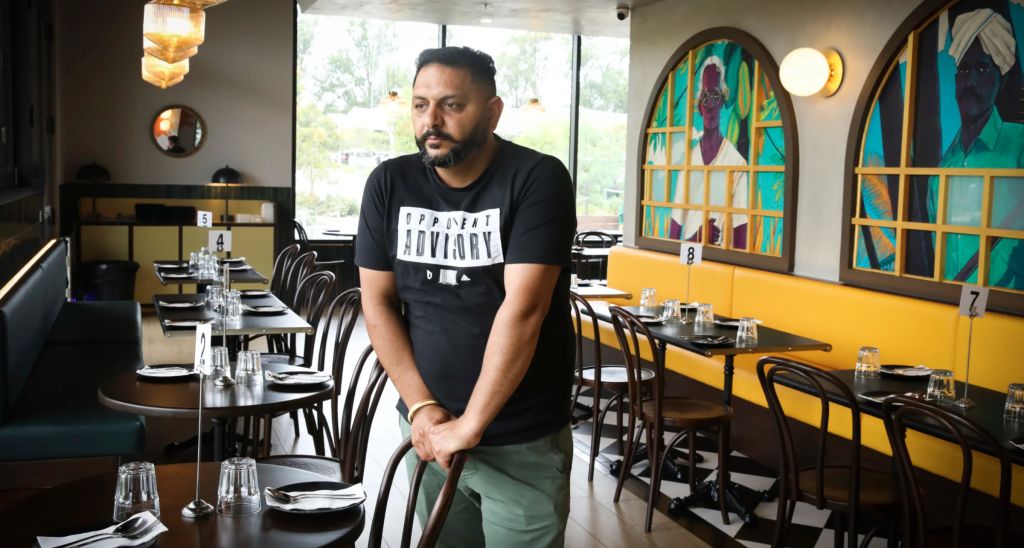
‘We can’t keep going like this’: Retailers struggle to survive Omicron wave
The last time consumers were this pessimistic about the economy, the Soviet Union had just collapsed, acid-wash jeans were in, and Shane Warne was making his Test debut. Needless to say, things are grim.
On Tuesday, monthly consumer confidence figures revealed a 7.6 per cent plunge in the closely watched statistics, clocking in at the lowest level for January since 1992, a month when shoppers are usually buoyed post-Christmas and looking forward to the year ahead. Now high streets and malls are eerily quiet.
It’s reflective of the wearied state COVID-19 and the Omicron variant has left the country’s businesses in, most notably the $360 billion retail sector, which has only recently recovered from last year’s harsh lockdowns. It was an unprecedented situation, where millions of Australians were bound to their homes and thousands of stores were forced to shut their doors, left to rely on online sales and government support to keep the lights on.
But for some retailers, such drastic measures would be a welcome alternative to the current “shadow lockdown” conditions plaguing the country, as soaring case numbers – rather than government edict – keep shoppers at home and wallets tightly shut, with no end in sight.
“The irony is, we thought it was pretty challenging through the lockdowns, but at least there were very clear deadlines and that narrative the government was providing around reopening dates,” says Cameron Fox, chief executive of ASX-listed grooming retailer Shaver Shop.
“Right now it’s a sort of pseudo lockdown scenario that we’re in, where there isn’t an official lockdown, but there’s no question the majority of the public are being a little bit more cautious.”
While businesses have become used to dealing with new challenges throughout the past three years of the pandemic, the recent Omicron outbreak has introduced unprecedented disruption through almost every facet of the retail ecosystem.
Labour is in short supply as workers are forced to isolate because of the virus, leaving shops without attendants and warehouses without shelf-stackers. Fresh produce has been left to rot as supply chains grind to a halt, and exports have dried up due to exorbitant international shipping costs.
Shelves at major supermarket operators Coles and Woolworths are bare, yet again, and Perth conglomerate Wesfarmers has recorded a 10 per cent slide in sales at its Kmart and Target stores as the pandemic scares away shoppers and disrupts deliveries. Even the country’s largest and most well-resourced corporations are struggling to keep things steady.
“Team member absenteeism associated with the COVID-19 Omicron variant has placed additional pressure on distribution centres and stores in some states, necessitating a reduction of trading hours in some stores and impacting supply chain productivity and stock availability,” Wesfarmers said earlier this week.
For many, desperate times have started to call for equally desperate measures. Ravinder Singh, who owns about a dozen Sehaj Indian Food and Sweets restaurants in NSW, said a shortage of professional chefs and a lack of overseas workers was forcing him to close venues.
Three of his restaurants are shut and he is contemplating closing a fourth after revenue from his businesses plunged 40 per cent. “Staff are getting infected with COVID and nobody is coming to work,” he says. “I had to sell one of my properties to help pay bills.
“I wish it would get better ASAP otherwise we will go broke. We have been struggling for the last two years. We are a small business, and we can’t keep going like this.”
Singh’s combined turnover is above $5 million and therefore disqualifies him from seeking rent relief from his landlords under the terms of the government’s recently extended mandatory code of conduct for commercial tenants.
Both NSW and Victoria have extended the mandatory code until the end of March in a bid to ease pressure on small businesses. The code requires property owners to negotiate rent relief agreements with eligible tenants in financial distress as a result of COVID-19.
The aid isn’t a moment too soon, according to tenant representative, Michael Amler from Verimark, who says Omicron is having a devastating effect on retailers. “Retailers are petrified at the moment. Christmas wasn’t great, but January is a disaster,” he says.
Foot traffic and visits to retailers in large shopping malls are down because people are terrified of catching the virus. “The biggest shopping centres are being hit hardest. People are tending to go to smaller centres because they feel safer there,” he says.
“All the small businesses I talk to say it’s far worse than COVID was the first time around because it is so widespread.”
Compounding the impact of the current Omicron outbreak are indications that the country’s retailers may have had a slower-than-expected Christmas, with bubbling fears about the virus subduing spending over the key shopping period.
Data from national credit reporting agency CreditorWatch shows that trading activity dropped to its lowest ever level through December, with trade receivables down a massive 45 per cent on the year prior.
Paul Zahra, the chief of the Australian Retailers Association, doesn’t believe things were quite that grim over Christmas, telling The Age and the Sydney Morning Herald he is expecting December’s retail trade numbers to hold up.
“But we are bracing for the worst when January’s numbers are released,” he says. “We’ve never seen the pandemic impact the sector on this scale, and for the first time retailers are having to navigate these challenges with reduced levels of government support.
“And the issue is, when does it end? Everyone’s watching the case numbers, hoping they come down, but what drives retail spending? It’s looking like months of pain.”
Even online retail, which has been the last bastion of support for many merchants over the past few years, has started to slow in the face of the virus. According to 6one5 Retail consultant Bill Rooney, the retail malaise has even spread to eBay, Australia’s top ecommerce site.
Unlike during COVID-related lockdowns earlier in the pandemic, search traffic on eBay fell between 8 and 10 per cent from July and December last year, he says. “It is a good indicator of where the market is at,” Rooney says.
Similarly, data from National Australia Bank shows that online trade has gradually been declining since the end of NSW and Victoria’s lockdowns, representing 12.5 per cent of all retail spending in November, down from near 15 per cent in September.
However, not all market-watchers are pessimistic, with analysts from investment bank Citi saying while January’s consumer confidence was poor, overall consumers were likely to show resilience as the pandemic wears on.
“To some degree, consumers are willing to look past the recent disruptions caused by the pandemic, which could be partly because Omicron is considered to be less severe,” they say.
‘For some small business owners, this will certainly tip them over. Without targeted support packages from the government, we’ve got grave concerns.’
Zahra and a coalition of other industry bodies representing the tourism and hospitality sectors have called on the government to act swiftly by increasing access to rapid antigen tests, expanding the isolation exemptions for retail workers who are close contacts, and handing out cash grants to small businesses most affected by the current situation.
“For some small business owners, this will certainly tip them over. Without targeted support packages from the government, we’ve got grave concerns,” Zahra says.
The desperate situation has even led to some calling for another short, sharp national lockdown in an effort to reset shoppers’ attitudes and provide an ‘end date’ of sorts to the current Omicron malaise.
One head of a national retail chain that has hundreds of stores, who did not wish to be named, told The Age and the Herald the federal government should just bite the bullet and lock the country down for a week to give a “symbolic start date” for things to return to relative normalcy.
“There’s so much confusion and chaos and the government’s got no idea what they’re doing,” they say. “As silly as this sounds, if they put everyone into lockdown for a week, everyone can then just come out and get back to normal.
“Because the biggest problem right now is that we have no idea when this will finish.”











